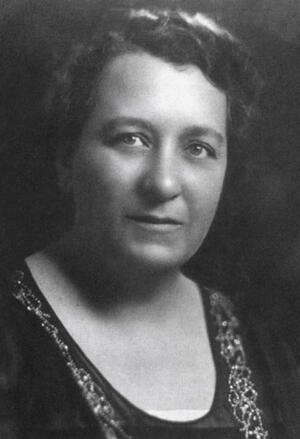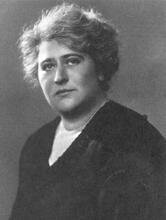Belle Moskowitz
Belle Moskowitz gained considerable power and influence as New York Governor Alfred E. Smith’s closest adviser. Moskowitz taught drama and directed entertainment events at a settlement house called the Education Alliance before working as an editor for the social reform journal The Survey. In 1918, she organized the women’s vote for Governor Smith and suggested he create a post-war Reconstruction Commission for the state’s industry. He appointed her secretary of the commission and later publicity director for the State Democratic Committee, where she wrote his speeches and edited his papers. Beginning in 1924, Moskowitz coordinated publicity and correspondence for his presidential campaign, creating a network of support that helped him win the primary in 1928.
Belle Moskowitz’s career is unique in American politics. After two decades as a settlement worker, social and civic reformer, and labor mediator, in the early 1920s she became one of New York governor Alfred E. Smith’s closest advisers. She organized his campaigns and served as a strategist in his “kitchen cabinet.” When he ran for president in 1928, she was by far the most powerful woman in the national Democratic Party—the only Jewish woman and the only woman unconnected to a prominent family to achieve such standing.
Early Life and Service
Moskowitz was born on October 5, 1877, in Harlem, New York, to Esther (Freyer) and Isidor Lindner. The Lindners, who had emigrated from East Prussia in 1869, ran a small jewelry shop on Third Avenue. Two older brothers survived into adulthood: Walter, later a corporate lawyer in New York City, and Max, a department store executive in Cleveland, Ohio. Educated at public schools, Horace Mann High School for Girls, and briefly at Teachers College at Columbia University, Belle trained to become a dramatic reader and taught dramatics to children.
In 1900, she took her talents to the Educational Alliance, a Jewish settlement on New York’s Lower East Side. After handling assignments such as the roof garden and “women’s” work, she became director of entertainments and exhibits. Her job was to organize monthly exhibits and orchestral, choral, and dramatic events. She also taught elocution to youngsters and coached dramatic groups. In the fall of 1903, she resigned from this job to marry Charles Henry Israels, an architect twelve years her senior and a volunteer club leader at the Educational Alliance. Although she agreed with her contemporaries that settlement work and married life were incompatible, after her marriage Belle remained active in social service. As she wrote in “The Jewish Woman’s Opportunity for Service,” published in the American Hebrew in 1917, “To think of others is as natural to the Jewish woman as to breathe. She gives and has been trained for generations to give with all her heart.”
Accordingly, even after she bore children, she worked part-time outside the home, earning just enough to pay for childcare. Editorial work for the social reform journal The Survey allowed her to pursue volunteer work through the United Hebrew Charities, the New York State Conference of Charities and Corrections, and the National Council of Jewish Women, New York Section. Working with this last group raised Belle’s awareness of a pressing social need, the lack of recreational and vacation resources for urban working girls. Under NCJW sponsorship, she began a drive in 1908 to license, regulate, and create substitutes for New York’s commercial dance halls. Social and settlement workers elsewhere later took up this cause, agitating successfully for dance hall regulations across the country.
To Belle and her husband, Judaism meant a shared history and perspective, more than a system of rituals. For a time, they attended New York’s Sephardi synagogue, Shearith Israel, but they disliked the Orthodox tradition of seating women away from the men. They soon shifted to Felix Adler’s Ethical Culture Society. When they moved to Yonkers, they found a synagogue more to their liking, but they remained admirers and supporters of Ethical Culture. Later they joined Stephen Wise’s Free Synagogue.
Career Achievements
In 1911, Charles Israels died suddenly of heart disease. To support her children, Carlos (b. 1904), Miriam (b. 1907), and Josef (b. 1909), Belle turned her volunteer experience into salaried work. She wrote a pamphlet on child care called The Child for the Metropolitan Life Insurance Company and then worked as “commercial recreation secretary” for the Playground and Recreation Association. The following year, she became grievance clerk for the Dress and Waist Manufacturers Association. This group had just signed a “Protocol of Peace” with the union in an attempt to halt the strikes then endemic in its industry. During almost four years with the group, Belle settled thousands of worker grievances and rose to head its Labor Department. Her relations with her employers were stormy, however. In November 1916, the association elected a new board and fired her.
She continued her volunteer work during her widowhood. In 1912, two groups invited her involvement: the Committee of Fourteen, formed to rid New York of its brothels, and a “Citizens’ Committee” investigating links between gambling and police graft. In 1913, a “fusion” political movement gathered around this latter group and elected a reform city administration. The new mayor, John Purroy Mitchel, appointed several social reformers to city posts. Henry Moskowitz, a settlement worker and industrial mediator, became president of the Municipal Civil Service Commission. The salary that went with this job allowed him to marry Belle.
Henry and Belle’s paths had crossed often on the Lower East Side and during her various reform campaigns. A protégé of Felix Adler and Lillian Wald, Henry had earned a Ph.D. in philosophy from the University of Erlangen in 1906. He later became head resident at the Downtown Ethical Society (Madison House), which he had founded in 1898 with some college friends. A founder of the National Association for the Advancement of Colored People in 1909, he was deeply involved in city fusion and state and national Progressive Party movements. Belle and Henry thus shared many interests. They married in November 1914.
Political Action
After she lost her job with the dress manufacturers, Moskowitz became a private industrial consultant. In 1918, she and Henry made a fateful political decision: They decided to support Alfred E. Smith for governor, despite his links to Tammany Hall, New York’s Democratic Party machine. As a member of an “Independent Citizens’ Committee,” a group of non-Tammany Democrats and former Progressives, Belle Moskowitz organized the woman’s vote for Smith (New York women won the vote in 1917). Her work brought her to Smith’s attention.
Smith’s victory, which came as World War I ended, prompted Moskowitz to suggest that he appoint a “Reconstruction Commission” to plan the course of the state’s future. He accepted her idea and appointed her the commission’s executive secretary. Its reports, issued between April 1919 and March 1920, covered five areas: labor and industry, the rising cost of living, public health, education, and government reorganization and retrenchment. The reports reflected the fundamental progressive creed of the era, that government should spur business interests to cooperate voluntarily in reform, but when voluntarism failed, the state should step in. Smith followed this creed in developing his Reconstruction Labor Board, a State Highways Transport Committee, expanded powers for the Department of Farms and Markets, and a State Housing Board.
During his first two-year term, Smith relied increasingly on Moskowitz’s political judgment and foresight. When he lost the 1920 election, he took her with him to the planning group developing a bistate “authority” for the Port of New York–New Jersey. Moskowitz devised the group’s public relations program, which included a pioneering nonfiction motion picture called “Mr. Potato” that explained how a port authority would reduce food costs.
Smith won reelection in 1922, thanks in strong measure to Moskowitz’s publicity work. He then offered her a government post, but she refused, choosing instead to create the post of publicity director for the State Democratic Committee. This post allowed her to perform many services for Smith—editing his public papers, writing his speeches, preparing and monitoring legislation, ferreting out information, and finding the right person for a vacant post. Her duties included distributing copies of Smith’s speeches and messages, sending out weekly news releases, and planting favorable editorial comment in newspapers. The job made her a central figure in the governor’s circle.
Moskowitz’s publicity work for Smith had three goals: to win support for Smith’s policies, reelect him, and after 1924 make him president. Developing citizens’ committees to promote his campaigns, in 1924 she churned out all the publicity and correspondence related to his presidential ambitions. When, in 1926, his fourth gubernatorial victory swelled his out-of-state support, Moskowitz coordinated the response, maintaining a vast correspondence and a card file on every Smith booster. It was this network that, in 1928, won the primaries and, ultimately, Smith’s presidential nomination.
Legacy
But it could not win Smith the presidency. Anti-Catholic sentiment, rejection of his stand against Prohibition, concerns about his inadequate preparation for the job, and his own provincialism combined to defeat him. During the 1928 race, Belle Moskowitz, the only woman on the executive committee of the Democratic National Committee, directed campaign publicity. After Smith lost to Herbert Hoover, Moskowitz stayed on as his press agent as he tried to retain his hold on the Democratic Party. In 1932, she organized his futile bid for the presidential nomination against Franklin Delano Roosevelt. In December, she fell down the front steps of her brownstone on West 94th Street and, while recovering from broken arms, suffered an embolism. Belle Lindner Israels Moskowitz died on January 2, 1933, at age fifty-five.
In an era when women, unless related by blood or marriage to political figures, never achieved proximity to political power, Moskowitz succeeded with Smith by offering him a selfless, nonthreatening loyalty. “She never belittled him,” labor reformer Frances Perkins said. “She never in the slightest way betrayed him ... never grabbed credit for herself. She gave it to the Governor.” Indeed, when friends spoke of Smith as her protégé, Moskowitz corrected them by calling him her mentor. This traditionally “feminine” political strategy allowed Moskowitz to exercise a level of power unprecedented for women in her time. It did not make her a “feminist” hero, but it did permit her to have a lasting impact on a major political figure.
AJYB 24:184, 35:127.
DAB 1.
EJ, s.v. “Moskowitz, Henry”.
NAW; Obituary. NYTimes, January 3, 1933, 1:4.
Perry, Elisabeth Israels. Belle Moskowitz: Feminine Politics and the Exercise of Power in the Age of Alfred E. Smith (1987, 1992).
UJE.
WWIAJ (1926, 1928).
WWWIA 1.





